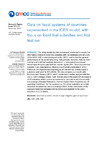This study details the first experiment conducted to couple the information relative to fossil fuel subsidies with the database and structure of the ICES CGE model developed at the CMCC, and to test the general performance of the model simulating their potential removal. Data for multi country and multi-fuel analysis derive from a “reconstruction process” based upon the price gap method, created by the IEA. The policy exercise consists in an instantaneous phasing out of existing subsidies in 2050. Removals are implemented imposing an ad valorem tax exactly equal to subsidies estimated by IEA (2009). We also compare our results with Burniaux and Chateau (2011) which conducted a similar analysis with the OECD ENV-Linkages model. Both models predict the expected decrease in CO2 emissions which is more pronounced in countries where the subsidy size is larger (Russian Federation, Former Soviet Union Countries and Oil exporting Countries). On the contrary the EU, where subsidies are small, increases its emissions due to a leakage effect. In the next phase of the research fossil fuel subsidies will be introduced explicitly in the price structure of ICES model.
- jel: Q41, Q48, C68
CMCC Divisions
Authors
- Keywords: fossil fuel subsidies, climate change mitigation, general equilibrium


